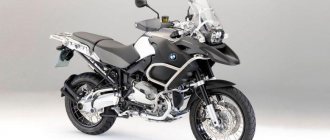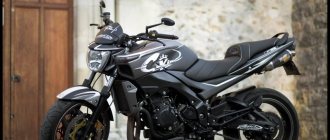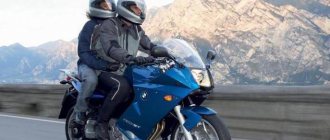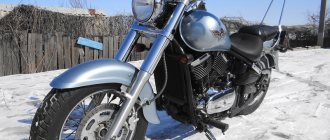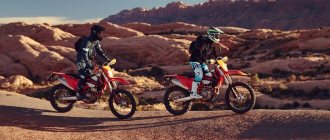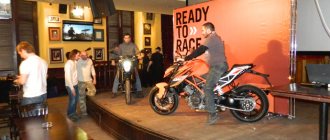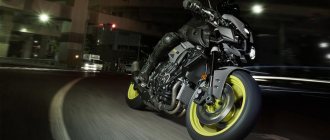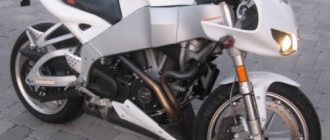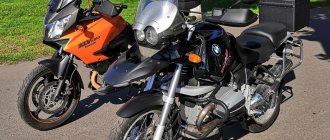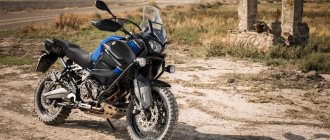Model class : sport-tourist.
Years of production/sales: 1999-2005
The BMW R1100S was first introduced on September 12, 1998 and positioned itself not only as a successor to the R100S series, but also as a replacement for the BMW R1100RS, which, although positioned as a sports tourer, was not much different from the R1100RT tourist. The new model BMW R1100S, as conceived by the engineers, was supposed to make a significant bias towards sportiness. At the same time, the concern called the R1100S the first supersport motorcycle with a boxer engine from BMW in the last 50 years.
Unlike the base model BMW R1100RS, the new R1100S has undergone many changes. Firstly, the model received a new aluminum frame (only the rear part is steel). Secondly, the proven 1085 cc engine. see was reconfigured and boosted, which ultimately gave 98 hp. power and 97 Nm of torque. Thirdly, the traditional 5-speed gearbox is replaced with a 6-speed gearbox, which is more common for motorcycles of this class. Fourthly, the model gets a completely new, more modern appearance, clip-ons instead of the usual steering wheel and a double exhaust pipe under the seat.
In all other respects, the model was very similar to other representatives of the R1100 series: proprietary Telelever and Paralever suspensions, injector, cardan drive, ABS and cantilever rear wheel mount.
Among the shortcomings, critics noted vibrations (the R1100S engine does not have balancers), which reduce the comfort of long-term travel at high speeds, and the “unsportsmanlike” engine - good traction at low and medium speeds, but maximum acceleration is observed only in a narrow corridor between 6000 and 7500 rpm. min, after which the motor stops. This characteristic of the engine increases comfort when using the motorcycle for touring, but partially deprives it of its “sportiness”.
The BMW R1100S model was produced until 2005, and since 2006 the updated BMW R1200S model appeared, which already had a different frame and engine.
Specifications
Technical characteristics of BMW R1100S:
| Model | BMW R1100S |
| Motorcycle type | sports tourist |
| Year of issue | 1999-2005 |
| Frame | aluminum 3-section (steel back) |
| engine's type | 2-cylinder 4-stroke boxer (Boxer) |
| Working volume | 1085 cc |
| Bore x Stroke | 99x70.5 mm |
| Compression ratio | 11.3:1 |
| Cooling | air-oil |
| Number of valves | 4 valves per cylinder, 1 camshaft per cylinder head |
| Fuel supply system | Bosch Motronic MA 2.4 injector |
| Ignition type | electronic |
| Maximum power | 98 hp at 7500 rpm |
| Maximum torque | 97 Nm at 5750 rpm |
| Transmission | 6-speed |
| type of drive | cardan |
| Front tire size | 120/70 ZR 17 |
| Rear tire size | 170/60-ZR 17 |
| Front brakes | 2 discs, 305 mm, 4-piston calipers (optional ABS) (from 2000 - 320 mm) |
| Rear brakes | 1 disc, 276 mm, 2-piston caliper (optional ABS) |
| Front suspension | BMW Telelever (rebound and compression adjustable), stroke - 110 mm |
| Rear suspension | pendulum BMW Paralever (preload and rebound adjustment), stroke - 130 mm |
| Overall dimensions (LxWxH) | 2180 x 880 x 1160 mm |
| Seat height | 800 mm |
| Gas tank capacity | 18 l (including 4 l reserve) |
| Maximum speed | 222 km/h |
| Acceleration to 100 km/h (0-100) | 3.7 sec |
| Motorcycle weight (curb) | 229 kg |
Powerful tourer BMW R 1100
A touring motorcycle with a two-cylinder boxer engine is the BMW R 1100 RT. Produced from 1996 to 2001 by the BMW plant (Spandau) along with several similar designs, including the R1100R and R1100RS, with almost identical engines but different trim parts.
After the R100RT, the R1100RT was released in 1996. In addition to the extensive changes, engine power increased significantly from 44 to 66 kW (60 to 90 hp) and displacement increased to 1,085 cc. cm.
In addition, the new BMW has the following characteristics:
- has a bore of 99 mm, stroke of 70.5 mm;
- compression ratio 10.7:1;
- maximum speed 211 km/h;
- acceleration time from 0 to 100 km/h is 3.9 seconds.
The BMW R 1100 gs is equipped with an anti-lock braking system and an adjustable three-way catalytic converter. The chassis is designed in three parts and consists of a front and rear frame and a cooperating geared motor ligand. The fuel tank holds 25.2 liters. Average fuel consumption is 4.7 liters per 100 km at 90 km/h or 5.6 liters at 120 km/h.
It is recommended to use gasoline with a knock resistance of at least 95 octane. The front tires are 120/70 ZR 17 and the rear 160/60 ZR 18. The motorcycle weighs 285 kg when running and has a maximum additional payload of 205 kg.
Models and competitors of the BMW R 1100
Touring motorcycles with comparable equipment and engine performance are the Honda Pan-European, Honda Gold Wing and Triumph Trophy 1200. The BMW R90S bahnstormer offspring arrived, appearing in century trim as the new R1100S. The 1993 S is the most powerful BMW Twin ever built.
Advantages
BMW's new model isn't intended to be a pure sportsbike, but the shell of the 1100S is an improvement. Provided that the basic tuning has not changed. Main advantages:
- less weight;
- more power;
- crisper steering;
- with a more sophisticated design.
BMW unveiled the 1100 at the end of June, coinciding with the opening of the Art of the Motorcycle exhibition at the Guggenheim Museum in New York. Engine BMW R1100S 1085 cc cm, air/oil cooled, four valves vs Twin. Forged pistons have higher compression with a 2mm thick top dome.
Forged pistons allow the redline to rise to 8,400 rpm from 7,900 rpm, while a vane air filter and redesigned intake duct improve airflow. The new stainless steel exhaust with integrated catalytic converter provides 70 percent of the power.
The new BMW R 1100 RS has 80 horsepower. Peak torque up to 200 rpm. The Bosch Motronic fuel injection engine management software has been recalibrated. oil pump capacity 350 cc. cm prepared to handle additional thermal loads. Magnesium valves and an alternator help keep the engine running, connected via a new hydraulic clutch to a much smoother six-speed transmission.
Reviews of the BMW R 1100 operation
Nikolay, 38 years old: “The unique A-arm front suspension of the BMW R 1100 S is attached to a new aluminum alloy frame, and the front suspension components are lightened. Machined (instead of cast) slider tubes give the S a unique look.
The new monotube gas shock serves as a Telelever damper, allowing only rebound correction. The single rear shock has 40-position preload spring adjustment as well as rebound adjustment. The steering geometry has sped up slightly. The steering wheel angle has increased by 1 degree. Such criteria allow you to use the motorcycle in any case and if necessary. The model is improved, but personal tuning is possible.”
Vasily, 41 years old: “I bought a motorcycle for myself. Good transmission, great cast spoke wheels from a K-bike. Dual 305mm front brake rotors lock directly onto the rim spokes and are clamped by four Brembo piston calipers. The model is practical to use and reliable. Moving over uneven and hard-to-reach places is now not at all difficult.”
SPORT + TOURISM = BMW R1100S
The pride of the car is the new engine
BMW, one of the leading manufacturers of motorcycles in Europe, recently introduced a new modification of the R series, designated R1100S. This name was not taken out of thin air - in the 60-70s, this letter denoted sports modifications that became classics, for example, R60S, R69S, R90S (the first BMW motorcycle to reach a top speed of 200 km/h), R100S and R100CS. Like the well-known R1100RS model, which has been on the market for several years, the new modification is designed to act in the sport tourer segment - the so-called sports touring motorcycles. Therefore, the R1100S is a kind of compromise between the K1200RS superbike, which is the top model of the BMW motorcycle range, and the touring versions of the R1100 series. In a word, if you like to wake up calmly resting citizens in the morning with the roar of a two-cylinder “boxer” and drive the proud owners of four-wheeled BMWs into depression with the dynamics of your “ground MIG”, but on a long trip you would want, in addition to everything else, comfort (that is, a non-positional seat embryo), then a sport tourer class bike is exactly the device you need. Character (sport) plus practicality (tourer) - these are the components of the success of these cars. It’s not for nothing that even the legendary Ducati relatively recently introduced a bike of this class into its program. So, R1100S. The pride of the car is the new engine, based on the 1100RS, but improved in such a way that the power increased from 90 to 98 hp. As a result, the S engine turned out to be the most powerful “boxer” in the entire 75-year history of the Bavarian company’s motorcycle department. For those who point to the K1200RS, let me remind you that the K series is a four-cylinder unit, and not the twin-cylinder boxer like the R series cars. Like the RS, the engine of the new S has a displacement of 1085 cc. However, in addition to power, it was possible to increase (though not much) torque. The gearbox is a six-speed (of course, Sport!) with hydraulic shift support. The operation of the “boxer” is controlled by Bosch electronics, which includes the MoDiTeC diagnostic computer, already installed on a number of BMW motorcycle models. The brake system of the machine can be equipped with ABS brakes upon request. By the way, this system was introduced by the company exactly ten years ago, and since then more than 200,000 BMW bikes equipped with it have been produced. In addition to the anti-lock braking system, the R1100S can be equipped with higher steering grips and a windshield (for long trips), heated steering grips, luggage cases, as well as elements of the “sport package”. The steering wheel is almost identical to that of the K1200RS and R1200C models; a speedometer and tachometer are installed on the instrument panel. Like all BMW models with boxer engines, the R1100S is equipped with a Telelever front suspension, which is also lighter by exactly one kilogram compared to its predecessor. The Paralever suspension is installed at the rear, which is also the company’s own development. Interestingly, it is not used on the only chopper in the company’s program, the R1200, which debuted as another “iron horse” of James Bond in the film “Tomorrow Never Dies.” The R1100S is unlikely to be suitable for jumping from overpasses and wearing a Canali tuxedo, but in terms of its dynamic characteristics it can easily make a low-speed chopper, even if the engine is 100 cc smaller. It's just that if the R1200 was created for lazy Americans who receive incomparable pleasure from a leisurely road raid with arms extended at the level of Ray Ban glasses in rocker gloves, then the R1100S is intended more for lovers of fast Eurocruises on weekends from Munich to the Cote d'Azur and back. Accordingly, the “engines” are configured for different operating conditions. The styling of the car is purely European - there is everything in moderation. Not as much plastic as the Honda CBR, and not as much naked hardware as the Electra Glide. The “muscular” front fairing, without any frivolous ventilation slits in the spirit of Testarossa (no longer fashionable) smoothly transitions into the “saddle”. The latter is made as a two-seater, and the rear one can be covered with a plastic fairing in the color of the body. The fuel tank fairing is integrated with the overall front fairing. The 18-liter fuel tank itself is made of aluminum to reduce overall weight, and its lid is sporty and polished. Wheel mudguards (the front one is made of carbon fiber to reduce weight - a first for BMW motorcycles), turn indicator fairings, mirrors are painted only in black, while all other panels are either yellow (mandarine) or brilliant red (brilliant red). ), or in black (nignt black); Moreover, if in the first two cases the seat is only black, then in the latter it is either orange or black. Despite some traditionality, the 229-kilogram R1100S is striking for its individual solutions, which include the asymmetrical arrangement of headlights, the “nostrils” characteristic of all BMW products in the front part of the fairing, two exhaust pipes located under the seat, and rear lighting technology. Adding to the sportiness of the car are 17-inch alloy wheels borrowed from the K1200RS. The BMW R1100S accelerates to 100 km/h in 4.0 seconds and has a top speed of 226 km/h. So be sure to be insured, wear a helmet, and have money for speeding fines. Otherwise, why buy such a motorcycle?
First 1000 km
So, a thousand.
I bought the bike with a mileage of 9819 km. Moreover, the motorcycle, for a moment, was born in 2004. Using simple arithmetic, we get an annual mileage of 818 km. Or 68 km per month. Does anyone believe that this can happen in the Land of the Rising Sun? I'm not very good. And I wouldn’t have believed it very much if it weren’t for the decorative and technical condition of the motorcycle: all the steel parts that could rust were completely rusted. The fastening screws for the front engine shield (generator protection), all the metal wiring fasteners, even the fins of the cylinders - all with traces of corrosion. It is not present only on painted or anodized surfaces, and on aluminum parts, of course. The remote controls on Rockster are painted, so it is impossible to determine storage conditions based on the structure of the surface layer of aluminum. The grips on the motorcycle are badly worn. But for BMW, the wear and tear of grips is a well-known thing, and besides, the bike fits with decent emphasis on the hands, so the wear load from motorcycle gloves on the grips is decent. But the footrests are slightly worn, and I did not notice any signs of their replacement. Moreover, the running boards are a rather rare “native” gray-blue color, and the previous owner wouldn’t have bothered with looking for original components (he didn’t worry about grips at all). All of the above gives a hint that the bike was stored for a very (!) long time without movement, so it is quite possible that the mileage indicated on the odometer has some relation to reality.
I repeat, so, a thousand. What do we have by this time?
SZhSP
To all the young men with burning eyes, I immediately answer the first question: “skokazhret-skokapret.” It now consumes 6.2 l/100 km, provided that I drive mainly around the city, and in about 2/3 of the cases I have the character of driving “punching through a traffic jam between the rows” (yes, yes, ah-ah-ah, I’m so bad — I use a motorcycle as personal transport). This is significantly more than on the Honda, but not critical, given the almost twofold difference in power and one and a half times in displacement. As for the second part of the question, I accelerated to 200 km/h according to the speedometer. Its declared top speed is 197 km/h, so it looks like the engine still produces full power. Which again hints that the 10K run may be real.
Just for reference: the tank is 20 liters. That is, 300 km between gas stations is a completely real thing, not even on the highway.
Now for more boring things.
Landing
It was neutral-dynamic, “street-style,” with a slight forward tilt. However, I rejected it; my hands and shoulders are not ready for this yet. I raised the handlebars using 25mm stem spacers. Now there is a very slight forward lean with my arms fully extended, and it has become more comfortable for me to ride.
Dynamics
The motorcycle has 86 hp. power at 7250 rpm and 98 Nm of torque at 5500 rpm. How do you think his dynamics are? Everything is fine with his dynamics. Of course, this is not a sportbike, but the finely chopped 6 gears at a very modest maximum speed make backfires on highways or starts from traffic lights an extremely unpleasant surprise for owners of 600 cc sports bikes. But it’s clear that I can’t argue with liter embryos or liter enduras in terms of acceleration. Plus, it should be noted that a single-disc clutch, although it grabs more clearly than a multi-disc clutch, however, requires more delicate handling at a quick start, and accordingly the slightest mistake leaves you with your nose. I'm not a fan of throwing a pen or setting a disk on fire.
Brakes are also an element of dynamics. Everything is simple here: there are enough of them everywhere and in general. ABS abeesit, but God, how she does it! Cutting off the braking force with a brake release frequency of 1 Hz and with the sound of a freight train's railway coupling - the first time I almost chewed half the seat with buns when I heard this cacophony from the rear brake, reinforced by the shocks in the million-numbered joints and splines of the transmission. But if you don’t get carried away with extreme sports on wet asphalt and don’t practice stoppies, then the rear brakes paired with the engine very well stop the bike in front of traffic lights, which is quite good in city mode. The front brakes (two 320 mm discs) seem to be able to replace a team of Tajik migrant workers tearing off the road surface to lay a new one.
Box. Oh, a box. Her name is the Source of All Universal Noises, but her work is simply amazing. Here's a really crazy clarity, perfectly matched foot stroke and absolutely absolute confidence that you will turn on exactly what you wanted, and not what the mechanics want. In this sense, even Honda's exemplary gearbox no longer seems so great. But it is 20 dB quieter and softer in operation than half a down pillow.
Sound
Some people think that all R-series engines within the same family sound the same. This someone goes to a motorcycle dealership and compares the sound of the R1150RT with the sound of the R1150GS. Then he returns and graciously asks to forget about his delusions.
So, the Roxter (and the R1150R, which is similar in hardware) does not have an exact analogue in sound. That's right from the word. The hooded Erteha/Ereska, not to mention Goose, sound different. Not to say it's different at all, but different. The exhaust pipes connected right after the pots give the bike a very unexpected birbyrbyr character. Up to 2000 rpm, it is a politically correct city dweller, which is completely inaudible without load, and with the handle unscrewed, it hums restrainedly, quietly declaring its two-cylinder power. From two thousand to somewhere around 3000...3500 it begins to howl, for some reason very much reminiscent of much smaller motorcycles. But if you wait until four thousand at full throttle and then through the peak of torque to the cutoff, then the bike turns into an evil roaring demon. Moreover, this bark remains low-frequency, there is no sports howl in the ultrasound, and especially the straight-through flatulence of night street racing. But "Rrrraaaaaayayayayayaaaaiayaaaaaaaaaaaaaaaaaaaaaaaaaaaaaaaaaaaaaaaaaaaaaaaaaaaaaaaaaaaaaaaaaaaaa very colorful. And the abundance of mechanical engine noise literally hammers into my ears nostalgia for the 638 Java and other air-cooled products from the times of my youth. But neither Java nor Izh were even close with 4 seconds to hundreds and an elasticity of 80-120 km/h at the level of “I thought - he did it even before the end of my thought.”
Control
I'm still that manager. I’m kind of used to a big and tall motorcycle, but I’m not yet ready to lay down the sparks from under the stand. On a low Honda, I polished the asphalt well with them a couple of times, but on the R1150R, in order to touch the wear pins to the road surface, you need to put the motz on a completely different angle. I'm not ready for it yet.
If we talk about the overall handling of the bike, then it is very good. If it were not for the mass of 235 kilograms and the corresponding inertial indicators, I would call the motorcycle’s habits quite bicycle-like. In any case, I feel more confident in stitching plugs on the Roxter than on the chopper format. You don’t have to take the pots sticking out on the sides into account at all - the steering wheel passed, and they will pass too. But the need to stand at the stop line on the toes of your boots is somewhat annoying. My height is 168...169, the seat is like a Japanese one (the lowest possible), but still, compared to Shadova, the German bike is akin to the Ostankino TV tower. The only thing worse is the Goose and other endurike bikes, but I generally only climb onto them from a stool, and in dense traffic jams these bikes need additional side wheels from a children’s bicycle.
Suspension
You know, I somehow completely forgot that the bike, it turns out, doesn’t bite when braking.
That is, already in the second week of driving, the absence of pecks began to be perceived as the norm. But other motorcycles crouching at the stop line began to cause surprise - is everything normal there with the springs inside? And, of course, the first trip on the chipped asphalt substitute immediately explained that miracles do not happen, and that for stable braking you have to pay for much less gentle handling of small irregularities. As for the general impression of the suspension... Damn, well, it's just some kind of classic German. Yes, there is a suspension. Maybe. Because it works completely silently, tightly and clearly, and you won’t even understand whether it’s there or not, and the bike moves on a short-stroke magnetic suspension. The nature of the handling of unevenness is very dense, that is, you always understand what your wheels are doing in close proximity to the asphalt. However, there is really not a single (!) reason to grumble about insufficient energy intensity or, conversely, excessive spread of reactions.
Sitting strictly in the center of the motorcycle places the center of mass exactly in the middle of the wheelbase. Coupled with a long front suspension arm (well, and a rear pendulum/cardan/gearbox/reaction brake lever/multimedia player/coffee machine/French mistress), the bike lives its own life under you, not particularly joyfully meeting the April Moscow asphalt, but is stable and indestructible moving forward , like the advance of German troops during the capture of Belgium.
Wind protection
No from the word “absolutely”.
It blows away after 120 km/h. Bubblebee's transformation into a shrimper (lay down on the tank and orgasm with his knees/elbows) helps a little, but driving like this for more than a minute is 80 lvl persistence. You will laugh, but Shadova provided greater wind comfort at speeds up to a hundred, and I didn’t want to go more than 120 on it. The trouble with the Rockster is that you want to wear it. But the lack of a windshield hinders my mega-professionalism as a speed racer.
This means that I will not install a windshield deliberately. Because I Googled a million minutes of YouTube and I know well that there is a motorcyclist’s main enemy. Let this stupidity limiter work for you. It won't be superfluous for sure.
Tags
- bmw
- r1150r
Full name BMW R1100R model 259R what do these letters and numbers mean? From personal observations:
Everyone understands what BMW is. When choosing a motorcycle, I did not make a choice based on some “magical” force of attraction of this brand. On the contrary, there was a prejudice that it was more expensive than technologically or qualitatively. Looking ahead, I will say that everything in terms of prices, quality and technology is approximately the same as that of the Japanese, with the exception of ABS and suspension. ABS is of course a breakthrough for those years when sales of this motorcycle began, and this is 1993. And the suspension is almost a unique technology for serial motorcycles. Although for the new capabilities of electronic telescope suspensions, the advantages of lever suspensions against the background of greater weight are not so obvious... for example, they did not install a lever suspension on the latest r1200r because instead of its central mounting there was room for a radiator. As I understand it, this is the main factor for abandoning telelever. But the new suspensions themselves seem to be excellent, but I haven’t driven them, so I don’t know what’s what.
In the brand name (I don’t know how else to put it) R1100R, the first R indicates the type of engine - boxer. There are also F, G, K, S, E and so on. And here I will go into more detail.
I used to be tormented by the question of why the hell R means boxer, because in German a boxer engine sounds like Boxermotor or, more simply, Boxer, why not B? The fact is that BMW's first motorcycle was the boxer R32, and the company itself started with aircraft engines, as we all know. But airplanes come later, motorcycles come first.
For Germans, a motorcycle sounds like Motorrad, consisting of Motor (motor) and rad (bicycle in this contextual meaning). In English, a motorcycle is “motorbike” and English-speaking guys, like the Germans, call motorcycles for short, “greats” i.e. “Bike”, and the Germans “Rad”. In our country, the word “Bicycle” sounds no simpler than the word “Motorcycle”; moreover, the word “Motorcycle” consists of the Latin “Moto” - driving and from the Greek “Cycle” - wheel. Therefore, no one here calls Moty great. It’s funny, because “Rad” is also translated from German as “Wheel”. So, without knowing a foreign language, just go through the synonyms, sooner or later you will fall into their language group and understand each other 
For the German BMW manufacturers, their motorcycles began with boxer engines, so in the company they added the letter R to the name of this first motorcycle engine (not the main production line), the first from the word “Rad”, which essentially means that the motorcycle engine is “for a bike” and now theirs is great becomes Motorrad R32.
The numbers 1100 are simple here - this is a rounded engine volume from the real 1085. Just like the Japanese round up, so that it is clear what tax class the equipment falls into in order to enter this or that market, where different countries have restrictions on customs clearance tariffs and etc. The only thing you need to know is that both the 850 and 1100 are marketing, not engineering. The motor itself was designed for an 1100 motor. So, when choosing an 850, you are taking a runt for economic reasons, it will not be easier to maneuver, etc.
By the way, the next generation already has 1130 cc. see, and a larger volume is achieved by increasing the diameter of the piston, but not the stroke, it remained the same, probably the head was modified in terms of the size of the intake and exhaust channels, but not a fact... In short, for fans of tuning on stock parts from the next generations, there is room for imagination. But there is no point in this if the current turbine is not screwed on... it’s cheaper to buy an r1200r. As I said above, this model has two types of engine capacity: 850 and 1100. I don’t know anything about the 850, how much it eats, I’ve never been interested in it at all, I won’t invent anything. But know that there is a “little brother”, and besides, it exists on other models of the family with a boxer engine.
The last letter R means Roadster or, as they often say on the Internet, a road builder.
I love Roadsters, Roadsters, classics, whatever you call them, for two reasons, the lack of fairings in the finished version, i.e. designed for such a concept and the ensuing thrills in the form of wind in the face, etc. And the second is the price tag; road motorcycles are usually cheaper than their larger touring, sports and adventure-riding brothers. There is, so to speak, nothing superfluous, just a motorcycle.
There are two versions of the motorcycle: pre-styling and restyling. I have a restyled one. They differ in tidy. There is also a classic with spoked wheels; in addition to the spokes, the wheel size is also different. I'm on casting. Front 17 rear 18.
In different families of different brands of motorcycles there is a different primary source from which the entire line of single-displacement (and sometimes neighboring engine displacement) models moves. The Japanese have a sports bike with a volume of one liter for which the engine is made from scratch and from this the engine is transferred to the roadster, trimmed according to HP. they make a heavy knee in order to mechanically obtain an increase in torque and a smoother schedule, etc. The gear ratio changes, 6th gear is selected, etc. castration actions. As an example, Honda cbr1000rr and cbr1000r. Or from the sport tourist VFR1200F to the crossover VFR1200X... I think you understand how this happens and there is nothing surprising in this, using technologies alone, which are quite successful, you can earn money several times over, everyone does this, including the automotive industry. In this regard, in the R1100 line, most likely the R1100R is also a derivative... from what? I still haven’t figured out whether Beha’s marketing processes are really smoother and more often intertwined with intelligent engineering ideas than the Japanese’s from Goose or RTech, but not always and not everything is so obvious...
Important point! My story of choice was marked by the fact that I crashed my beloved Honda x4 and could not come to terms with it. I launched an iron horse into deep customization, which became beyond my means in terms of money, time, or knowledge. In short, I decided to build a “turbo cramp,” as it is now fashionable to say, with global alterations in the chassis, the transition to an injector, etc. I realized that I was spending the next season in the garage, making an old friend and walking. I was not satisfied with this idea. It was decided to take out a loan and buy a motorbike “for a while,” ride the season, sell and close the loan before the wedding, which was scheduled for the fall. But I became attached to him and now I have two spendthrifts, a wife and a loan! Life is pain - everything is decay! ©Max.
I saw the budget at 200 thousand and at first I was sure that I would take another X4... The Japanese did not have anything among similar equipment that would in any way interest me in its consumer characteristics comparable to the X4, it is important to note once again within the budget of 200 000. But then I thought that “I want to see the light” and turned my attention to Europe and other classes of motorcycles. BMW came up with a very nice BMW R1100R for my perverted taste, and what’s more, with ABS and the famous wishbone suspensions, which actually turned out to be really good. Yes, it is never the same in dynamics as the X4, the cardan licks up a good torque, after all, the chain gives away most of the pie. I managed to feel this nuance after riding a Vmax 1200... the numbers seem to be big in terms of performance characteristics, and due to the flimsy bicycle frame, of course it’s scary! It seems that you are driving like hell, it feels like in an old domestic classic after a foreign car. Where the same speed brings different emotions. I hope you understand what I mean. In real life conditions, the vmax winds most of the torque onto the cardan, and the narrow wheel smears with slipping on an imperfect surface, and the peak of torque at higher speeds needs to be cranked up the engine and the clutch released so that it just as quickly engages in the torque plateau... No, mot very good, I like him, even much more than others and occupies a high position in the personal rating, but after X4 it’s not like that!.. it’s like a step back... X-drivers will understand, and I hope Vmax-drivers will forgive. In short, I decided not to look among the Muscle Japanese and put other characteristics of the motorcycle at the forefront and found them in this wonderful Beha.
So, let's start the review about everything in order and list both the positive and negative features: Kommersant
2nd number.
For my wife, who is 163 cm tall, it is very inconvenient for two reasons. 1) Uncomfortable saddle: hard, flat, no support, the passenger rolls onto the driver. It is not justifiably long, but it seems that if you change the profile correctly, add a strap and handles on the sides (and there are none), then this length will become a plus, it will be possible to change position, fidget back and forth, without fear of falling off the bike or crawling onto the driver . 2) The second point is related to the running boards, they are very close to the driver’s and the passenger and driver interfere with each other. This can also be cured, but to do it beautifully is to grind out new ones, and you will have to worry about it, since the back of the footpeg platforms is a stop for the side panniers. Everything needs to be calculated correctly. By the way, I’ll try to do all this if I have time before the start of the season.
Driver ergonomics.
The driver's saddle is very comfortable, but the bike came to me with a re-sewn saddle, I don't know what kind of filler is there, maybe even gel, I have never touched a reliably gel saddle. The height of the saddle allows you to confidently stand on two feet on the ground (my height is 177, weight 75). The steering wheel is very comfortable, many people don’t like its design and say that they would replace it with a cross-country bike or a stick, or a cafe one. I partly share their opinion, but only if the whole moto is made in the café racer style, and this moto is an excellent preparation for such a project, by the way.
The dashboard has a standard odometer, speedometer, tachometer and a completely unnecessary clock, and many people agree with me on this. It would be better to install a fuel indicator, its role is played by the reserve light, but there is no switch, it lights up and you start to panic in the long run. In the center there are three hazard warning buttons (it’s not convenient to use when removing your hand from the steering wheel), an ABS (HZ) button, and a button for heating the steering grips, which operates in two ranges: hot and very hot. Works great, very useful in October. Although I was not embarrassed to use it on cold nights in the summer. You get used to good things quickly, now this is the norm, before it was a luxury from BMW.
Another feature is the inclusion of turn signals; each pair is turned on by a button on the corresponding side of the remote control, and turned off by a separate button on the right remote control. I’m still not used to turning it off - it’s very inconvenient to turn it off without releasing the gas. Plus, there is a joint between the plastic of the two halves of the remote control and the seam of the glove gets caught there, or if summer gloves are fingerless, then this piece of plastic gets under the nail, in general, Hellish Hell!!! Although maybe my hands are crooked... So let everyone check this moment for themselves.
There are no complaints about the driver's footrests; the legs are comfortable. I will attribute one more point to ergonomics - this is a bonus from the heat of the cylinders and, in principle, protection from dirt and wind. I honestly really like this bonus. I mostly ride in motorcycle boots and have never felt hot in them, so much so that I experienced serious discomfort. In sneakers you feel it, but only in a very slow traffic jam, but it’s the same - it’s not hot, you just feel that there is an engine, the engine is warm. It’s more likely that in a traffic jam it’s generally hot in the protection, and the heat from the engine there simply adds its share of heat. But again, this is more of a fat plus in cool weather, and a skinny minus in hot weather.
Protection
Well, the cylinders themselves are a natural protection for the legs, there are optional original arches, unfortunately I got the bike without them, but they could have been hung for fog lights, but there’s not really anywhere to hang them. On the cylinders themselves I have metal linings covered with plastic, this gadget was installed by the Japanese, they are made by the Chinese on Ali, you can find them for pennies, they will protect only if you carefully place them on hard asphalt or concrete in your hands. I caught the bump stop while moving and scratched the side cover; the bump stop went over this pad. Although they don’t look bad if you run into the soft doors of Salyaris in a traffic jam (and I know a lot about the softness of Salyaris), I think they will work with a bang.
The same ABS, I can’t say anything bad about its work - it works. The service people say that it is very reliable compared to subsequent generations from 1150, there is some kind of epidemic with their ABS. Very often I see in communities how they are trying to find ways to cure it and are indignant at the high price tag for a new one. At such moments I am once again convinced that I did not make a mistake with the version of the spendthrift. This version of the R1100R also has a steering damper in stock; the R1150R no longer has it, which is strange. But I had problems with this damper: the oil seals were leaking, I changed them, but I couldn’t find the viscosity of the oil; even the thinnest one gives a very high resistance at about zero speeds, it’s simply impossible to turn the steering wheel. As a result, I decided to restore it or buy a Chinese one; they have been making them in a wide variety for a long time. There is no desire to buy an original, it costs a lot and there are no adjustments, and the maintainability is so-so, you need to make titanic efforts to remove the retaining rings and not scratch the rod. According to the manual, it is not collapsible. I screwed up the rod, but you can forgive me; my crooked hands get stuck in the plastic of the remote control. In short, we will change it, fortunately there is a bracket, there are standard holes, you just need to pick it up, configure it and ride it.
Optics
Let's start with the turn signals. They suck. And there are several reasons for this. Flimsy leg, one of the four has already arrived with traces of epoxy restoration. The glass pieces are very fragile and constantly fall off due to vibration. In fact, they are made as disposable ones; the self-tapping screw is screwed through the plexiglass of the reflector into the plastic case. If you don’t reach it, it will fall off; if you tighten it, it will crack and fall off. They are unreasonably expensive relative to their archaic design and construction. I will definitely change them to homemade ones. So in one season I changed three glasses and once repaired the (same) body leg. Although I must say that they shine well, since the size is large. They come with white and orange glasses; both options are in the original catalogue, so you don’t have to think that the white ones are necessarily from China. The brake lights and lights are beautiful and shine well, no complaints about them. But I will upgrade all the optics to LED. And then you will understand why. I got the main headlight with a Japanese bias towards oncoming traffic. Moreover, with xenon installed. How does such a set shine? In all directions - on the near side, in all directions and into the sky - on the far side. I decided to change it to an LED module, similar to those that the Chinese make for Harley Davidsons, only with an angel eye - this is Beha.
As a result, I can say about the optics that in its stock form it fully corresponds to the spirit of the times and the technologies of the early 90s. Now it shows the age of the motorcycle, but affordable solutions can give the motorcycle a modern look and improve visibility and visibility. But not everyone likes such transformations; some prefer the stock look; I understand them; with any tuning, it’s very easy to make it worse than it was from a design point of view, a combination of old and new elements. But I will try to maintain the classic style. Well, then evaluate it.
Brakes
The brakes are very effective, I got them with reinforced hoses and fittings made of stainless steel, and they look very high quality, not cheap from Ketai, and even if they are Chinese, they’re definitely not cheap.
Brake discs, machines, calipers, pads are Brembo, and it all works like the best braking system in the world. ABS allows you to push the front brake as hard as you can without fear of locking up and tearing the front wheels off, combined with the sharp efficiency of the Brembo, the whole system works great, the only weak point is the rubber and the quality of the surface underneath it.
Here it should be noted that when buying a motorcycle, I noticed that the brake discs were practically new. And if they told me that the motorcycle has a mileage of 8,000 km and I estimated it based on these brake discs, I would easily believe it. But I definitely knew for sure that the mileage of the motorcycle I bought was 101,000 km. So you should not 100% trust the standard motorcycle inspection criteria to determine their actual mileage. And in general there is no need to consider mileage as a very important factor. On the contrary, appearance is much more important. From a well-maintained motorcycle you can expect careful care and timely maintenance. And vice versa, if somewhere there are non-original fasteners and red sealant hanging from under the covers, expect problems in everything that was touched by the hook hands of the former owner (his master craftsmen).
Suspension and wheels
The second generation rear paralever and front telelever work perfectly. Before buying the motorcycle, I had doubts that there would be a big difference. But there is a difference, the whole difference lies in comfort. I simply find the handling itself to be sufficient and I can only praise it for its excellent cornering behavior when braking. There is no dive when you brake before a turn, and you no longer go through the turn with a “loaded” front suspension, as on a telescope.
However, it should be noted that I got a motorcycle with tuning and suspension. Both front and rear have adjustable Yolins shock absorbers. I still haven't figured out their settings. No... don't get the wrong idea... I found the instructions, I understand what to twist to make it higher or lower, to increase or decrease the spring stroke, to make it harder or softer. But in order to adjust this not by smell, but by feeling which changes become more useful to you, you need a certain approach. Due to the lack of experience in setting up suspensions with such ranges and quantities, you need a testing ground, special keys and patience, since getting to some twisters is not so convenient and the turning amplitude is very small, but everything is possible. To figure out these settings you need a great desire and a whole day, in my advanced case, since I do not live next to a free winding road, with elevation changes, etc. I live in Balashikha and, unfortunately, I have the best testing ground in the world for testing motorcycles in traffic jams.
The wheels are dull in design, three-spoke ones are relevant for the 80s, I think repainting them might turn out to be more interesting. The rear wheel is R18, which makes it very difficult to find suitable tires. I decided to try the Scrambler pattern and found only Shinku, and only 10mm narrower than the standard size, 150 versus 160 and at the same time a little taller... Well, let's try. The front disc is all standard R17, the most popular size of the front wheels is all sizes. There is also a Classic version with spoked wheels. On the contrary, there is R17 in the back and R18 in front. Wheels with spokes are difficult to find separately and usually cost 30 thousand for them.
Baggage
The bike came to me from Japan with one left case. Cases vary in lid volume; I got one with a narrow lid. I knew that he would arrive with one case and, having rummaged through the topic of cases, I ordered the right case with a deep lid assembled and the left deep lid separately. This set came to me from Japan faster than the motor itself. Having received the bike and putting on both “large” trunks, I realized that in this form it was too wide and looked pot-bellied. I decided that I wouldn’t use it with large panniers in the city. So during the season I didn’t use them even once because I didn’t go somewhere very far and for a long time. But for this season I decided to buy another narrow cover and drive around the city with two “narrow” panniers, it looks very original and there is a useful place. I haven’t ordered the cover yet, I can’t find a used one, and a new one is a little expensive, but it’s tolerable, while I’m monitoring, maybe a used one will turn up. At the same time, there are a lot of deep covers and they are cheap.
There was no central trunk or platform for it and the moto. But I don’t really want to buy it because what the Internet offers doesn’t look very nice or reliable, and the price tag is also high, and the volume of the original case is small. In addition, I have a large Kappa trunk with a capacity of 53 liters, I need to make a platform. But the design of the frame is such that it’s good that it needs to be supported by pipes where the footrests are attached, I haven’t figured out how to do this gracefully and quickly. By the way, the central trunk and the platform for it were not planned by the factory. As a rule, everyone who bets takes Givi aftermarket.
Dynamics
My perception of the Beha's dynamics is very subjective, since I got on it from a more dynamic moto. And at the same time, I find it quite playful, since its not very heavy weight, coupled with a comfortable suspension and braking dynamics with ABS, allows it to confidently drive quickly, but the engine does not justify its character (where there is more torque than horses and all of them are available in the area mid-rpm). If you wish, you can allow anyone in the city to be caught up in the aisles with a roar of gas, to be driven out of the way and rustled to the point. It is clear that for every fastest person there is a Valentino Rosi, but the spendthrift is already in that “weight category” where skills and lack of self-preservation instinct are more important than horsepower.
But this is true for the city. On the highway everything is sad, as short 5 gears end at 200 km/h. And already at these speeds it blows away so much that you have to lie on the tank with your elbows up and there’s no talk of any maneuvering.
It's a roadster, naked, classic, whatever you want to call it, but it's not a sportbike, thank God. So, when overtaking a sportbike from a traffic light, up to 100 km/h you can be happy, and then turn on the turn signals and pretend that you need to turn urgently, otherwise it will pull you back to 200 km/h, and then the lag will simply not be decent. Don't let the big engine fool you.
Consumption and range.
Consumption is low, in the city it’s about 6+ liters (if you don’t anneal it, don’t create illusions), on the highway it’s even less, it’s like driving there. Since I have never drained the tank, I can’t say for sure exactly its volume. Around 19 liters, of which it is available (used before the light comes on), about 14-15 liters, this is about 250 km. There is a fuel pump in the tank and, like all pumps, it is afraid of running dry. I think no one will take risks on the road and will always have a reserve in the tank and use those same 15 liters... and then rush to the gas station. However, it should be noted that the Boshevsky fuel pump is unified with a huge number of cars; finding and changing it on the road will not be a disaster. It's not so easy to pick it out of the tank; you have to fiddle with the contacts, but everything can be solved in the field. I took it apart myself when I changed the fuel filter - it’s in the tank. By the way, on Russian cars it is almost identical, only the terminals are different, you just can’t put a chip on it, you need to farm it or remake it for a VAZ one.
Unfortunately, there are restrictions on the number of letters, to be continued later, as an inexperienced user, I can’t publish often, I can’t post two parts in a row...
